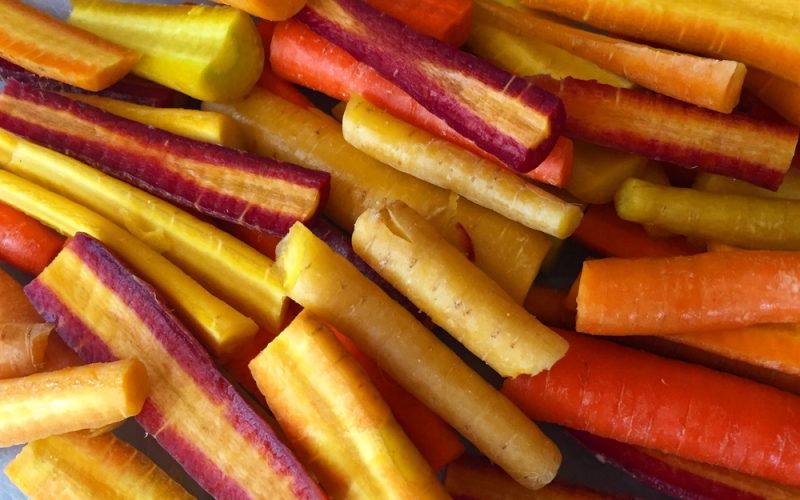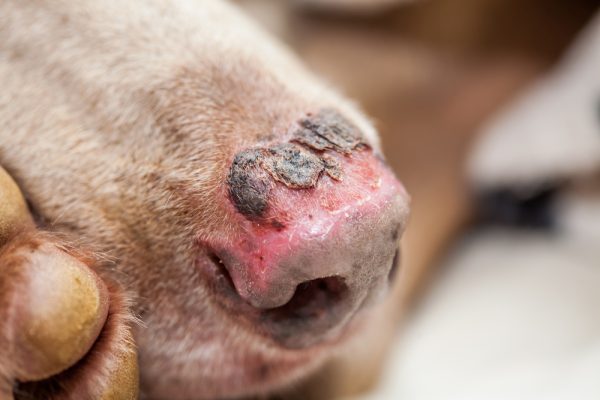In this article
View 3 More +If your dog has been affected by pancreatitis, you know how important their diet is to their long-term recovery. One of the most difficult parts of this for most owners is feeling like they can’t give their dog treats. Although it is vital for dogs with a history of pancreatitis to avoid rich, fatty foods, there are still ways we can offer them a tasty reward without risking their health. After all, a treat doesn’t have to be unhealthy; it’s all about how it is given and the fact that it’s something different from their normal daily routine.
We’re going to check out some fruit and vegetable treats for dogs with pancreatitis, but first, we’ll do a little bit of a recap on the disease that has led you here in the first place.

What Is Pancreatitis?
As the name suggests, pancreatitis is the inflammation of the pancreas. But what does that mean, and why is it such a big deal?
A healthy pancreas is a pale pink, thin, blobby-looking organ that sits in the middle of the abdomen between the stomach and the small intestine. It’s not much to look at, but it is made up of two distinct components comprised of different cell types, each performing very important roles:
The Endocrine Pancreas
The endocrine, or hormone, division of the pancreas is responsible for controlling blood glucose levels, which it does by producing insulin. When food is digested, insulin is secreted, which pushes glucose from the bloodstream into the cells, so it can be used as energy. When this part of the pancreas isn’t working properly, the result is diabetes.

The Exocrine Pancreas
This is the part of the pancreas that produces digestive enzymes, which travel along the pancreatic duct into the first part of the small intestine, called the duodenum, to help break down and digest food. When this process is disrupted, the digestive enzymes can be activated before they reach the duodenum, and they start to digest the pancreas itself.
This leads to the damage and inflammation that is pancreatitis, which ranges from mild abdominal discomfort and nausea to extreme pain, vomiting, diarrhea, and inappetence. In severe cases, the pancreas can become infected or necrotic, leaking digestive enzymes into the abdomen and resulting in potentially fatal peritonitis.

What Causes Pancreatitis?
There is no single known cause of pancreatitis in dogs, but there are many factors that can trigger it.
- Trauma (damage to the pancreas or pancreatic duct)
- Eating a rich, fatty meal
- Acute or chronic gastroenteritis
- Corticosteroids (e.g., prednisone)
- Hyperadrenocorticism (Cushing’s syndrome)
There is no specific treatment for pancreatitis, and affected dogs require hospitalization to provide intravenous fluids, pain relief, gastric acid inhibitors, antiemetics (anti-nausea medication), and antibiotics (if infection is present).
Provided your dog recovers from pancreatitis, they remain at high risk for relapse for weeks or even months following their recovery and are more likely to be affected by pancreatitis in the future. For this reason, dogs with a history of pancreatitis are usually placed on a strict diet to minimize the risks of repeat episodes. This may involve a specific veterinary diet or a list of foods to include and avoid.
Number one on the list of foods to avoid are traditional treats. No more milk bones, biscuits, or bacon bites. But that doesn’t mean that your dog faces a future devoid of tasty snacks, we just need to redefine what we call treats.


Safe Fruit and Vegetable Treats for Dogs With Pancreatitis
Whether your dog recovered from pancreatitis last month or last year, it is important to keep their diet free from rich, fatty, or calorie-dense foods. So, what fruit and vegetables are good for dogs? Fortunately, there are dozens of fruits and vegetables that we can use to reward our dogs. One thing to be aware of is that most fruits are high in sugar, so we need to be careful not to go overboard with our portions.
In all cases, fresh is best, but if your dog prefers their veggies warm, steaming or blanching will allow them to retain most of their nutrients. With the exception of some potentially problematic items listed later, most fruits and vegetables can be offered on their own, as a mixed fruit or vegetable medley, or combined with their regular food. Just remember that treats should never make up more than 10% of your dog’s diet.
For those of you who would like to go that extra mile when preparing a tasty snack, we’ve included some simple recipes and ideas for treats that dogs with pancreatitis can enjoy, most of which you can enjoy along with your dog.
Safe Fruits and Veggies for Dogs With Pancreatitis
- Radishes
- Pumpkin
- Butternut squash
- Apples (remove seeds and core)
- Peaches
- Plums
- Sweet potato
- Bell peppers
- Carrots
- Papaya
- Raspberries
- Blueberries
- Broccoli
- Cauliflower
- Peas
- Squash
- Pineapple
- Green beans
Always make sure to wash your fruits and vegetables before preparing them, even if you buy organic. Remove any tough skin before serving and be sure to remove the seeds and core of apples and the stones and pits of stone fruits, like peaches, plums, and apricots.

Fruits and Vegetables to Avoid When Your Dog Has Pancreatitis
Some fruits are toxic to dogs, and others simply aren’t ideal for those with a history of pancreatitis or gastrointestinal disease.
| Fruit/Vegetable | Reason |
| Grapes, raisins, sultanas, currants | Toxic to all dogs |
| Avocado | Potentially toxic to all dogs |
| Citrus fruits (lemon, orange, grapefruit) | Citric acid could inflame the stomach |
| Dried fruits | Too high in sugar |
| Potato | High in starch, more difficult to digest |
| Mangos, pears, bananas | Too high in sugar |
We recommend seeking veterinarian advice before making any changes to your dog’s diet
If you need to speak with a vet but can't get to one, head over to PangoVet. It's an online service where you can talk to a vet online and get the personalized advice you need for your pet — all at an affordable price!


The 4 Vet-Approved Treat Recipes for Dogs With Pancreatitis

Fruit Salad
Ingredients
- ½ cup diced papaya
- ¼ cup blueberries
- ½ cup raspberries
- ½ cup melon balls or cubes any melon is fine
Instructions
- Wash the fruit.
- Cut them in small pieces your dog can chew.
- Then mix together and serve.
Notes
Nutrition
2. Veggie Batons

- 1 carrot (no need to peel)
- 1–2 sticks of celery
Wash and cut the carrot and celery into batons 2 inches long and half an inch wide. It doesn’t get simpler than that! You can also try zucchini or bell peppers for a bit of variety.
- Serving size: Small dogs: 3–4 batons; medium dogs: 7–8 batons; large dogs: all the batons
3. Sweet Potato Chips

- 1 small sweet potato
Peel one small sweet potato and cut into thin slices (around 2–3 millimeters thick). Pop the slices on some baking paper and cook in a hot oven for 5–10 minutes until just starting to brown. Allow them to cool before serving. You can do the same with purple yam to mix things up a bit, and if you have an air fryer, this is a perfect opportunity to make use of it. Do not add any oil, salt, or seasonings.
- Serving size: Small dogs: 2–3 chips; medium dogs: 4–5 chips; large dogs: 8–10 chips
4. Icy Fruits

- Blueberries, strawberries, raspberries, or a mix of them
Take a selection of smaller fruits or fruit pieces, such as blueberries, strawberries, or raspberries, and place them in an ice cube tray. Add water and freeze completely before serving. These are perfect for a warm day!
- Serving size: Small dogs: 4–5 cubes; medium dogs: 5–6 cubes; large dogs: up to 10 cubes

Summing Up
When it comes to managing a dog with pancreatitis, providing them with the right foods is essential. But that doesn’t mean that you can’t explore some healthy options to treat your canine friend. Always talk to your vet before making changes to your dog’s diet, and make sure that they have fully recovered from pancreatitis before exploring different foods.
Some dogs are pickier than others, and it might take some time before you find a fruit or vegetable they like. It’s also worth remembering that for our dogs, a treat is often about how it is given, not the food itself. Keeping a small portion of their regular food in a separate container to give as a treat can be just as rewarding as giving them a milk bone if you do it with lots of praise.
Pancreatitis is a potentially life-threatening illness that can come back to haunt us if we’re not careful, so stick to your vet’s advice and watch out for any signs of nausea, pain, or discomfort, especially when offering your dog a new type of food.
See also:
Featured Image Credit: heathergunn, Pixabay






















10 Responses
Thank you for all the information, it truly is very helpful.
For a treat is giving them pumpkin; steel oats and egg ok for a dog with pancreatitis?
Thank you!
Hello Barbara,
thank you for your question, although I am afraid that we can't give you a straight answer. Dogs with medical issues need to be feed very particularly and the only one who can advise on what to feed them is their attending veterinarian. Therefore I suggest to reach out to them with this particular question.
Have a great day!
I have a Yorkie and make her homemade dog food. She was 10lbs 8 ozs and she is now 9 lbs. should I be concerned about the weight loss? She is acting fine. She has pancreatitis so I avoid sugar and salt.
Hello Jo,
thank you for your message. Unfortunately, it is difficult to give advice in such serious matters, based just on a brief description. There are more factors that determine whether your Yorkie's weight is appropriate, such as body condition score. However, since your dog has pancreatitis, the situation might be different.
This would be best consulted with a veterinarian, since amongst other things, your dog's nutrition and health condition must be evaluated. You can book a 20-minute video call with one of our professional veterinarians from www.PangoVet.com and ask all the questions or voice any concerns you might have.
Hope this helps.
I have a 13 year old dog who is suffering from active pancreatitis. As I have now had Minnie on R/Canin low fat for a year , I feel cooking fresh for her from now on is the way forward. However , although I'm a retired vet. nurse , I am not a nutritionist, and need advice on ratios and suitable ingredients. At the moment I have her on Milk Thistle , Cobalin , Vetmedin and Lypex. For only 24 hours I have been feeding her low fat , cooked drained turkey thigh mince , cooked peas and either cooked sweet potato or cooked rice , in a 1:1:1 ratio , with promising results. My vet. , who is a cardiologist , cannot advise me on nutrition other than suggesting the Royal Canin. Please help. Regards Mrs. Pargeter.
Hi Jill, thanks for reaching out. That's great that you are taking the right steps to help Minnie with her diet. Nutrition can be quite complicated, especially when pancreatitis is involved, so you aren't alone if it feels a little overwhelming. We do offer an online vet service, PangoVet. To ensure they can provide you with the best, most helpful, and effective support, we kindly ask that you schedule a call with us. This will give our veterinarian team the ability to fully understand you and your pet’s needs and provide you with tailored personal advice. You can book a time that is convenient for you at this link here https://pangovet.com/schedule-appointment/. We look forward to speaking with and helping you and your dog.
I'm so thankful for this info
Dawn klink
Hello Dawn,
thank you very much for your feedback. We are glad that you found the information in our article helpful, as that's our mission!
Best wishes
thank you
You are very welcome, Mireya. 🙂